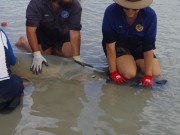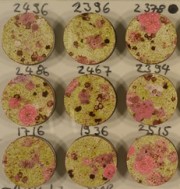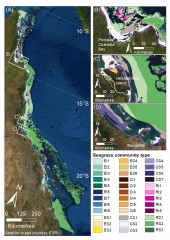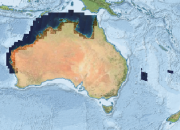Recent datasets

This record provides an overview of the NESP Marine and Coastal Hub small-scale study - Project 3.8 – Carbon abatement and biodiversity enhancements through controlling feral ungulate disturbance in wetlands. For specific data outputs from this project, please see child records associated with this metadata.

This record provides an overview of the NESP Marine and Coastal Hub study - Developing Traditional Owner community-led dugong monitoring in the Kimberley region. For specific data outputs from this project, please see child records associated with this metadata.

This record provides an overview of the NESP Marine and Coastal Hub study - Project 3.20– A National Approach to Indigenous Engagement in Australia’s Blue Carbon and Environmental Markets. For specific data outputs from this project, please see child records associated with this metadata.

This record provides an overview of the NESP Marine and Coastal Hub small-scale study - "Scoping Study: Horizon scan of key science questions in the decommissioning of offshore oil and gas infrastructure". For specific data outputs from this project, please see child records associated with this metadata.

This record provides an overview of the NESP Marine and Coastal Hub small-scale study - "Scoping Study: New Approaches to Marine Monitoring".

This record provides an overview of the NESP Marine and Coastal Hub study - Project 3.12 – Closing the gap in bycatch reporting and population assessment of sea snakes in Northern Australia". For specific data outputs from this project, please see child records associated with this metadata.

This record provides an overview of the NESP Marine and Coastal Hub study - NESP MaC Project 3.19: Addressing Kakadu’s strategic marine research needs.

This record provides an overview of the NESP Marine and Coastal Hub study - Protecting valuable shoreline mangroves of northern Australia. For specific data outputs from this project, please see child records associated with this metadata.

This record provides an overview of the NESP Marine and Coastal Hub small-scale study "A roadmap for coordinated landscape-scale coastal and marine ecosystem restoration". For specific data outputs from this project, please see child records associated with this metadata.

This record provides an overview of the NESP Marine and Coastal Hub small-scale study - "A pilot study into the movement and dispersal of sawfishes". For specific data outputs from this project, please see child records associated with this metadata.

This record provides an overview of the NESP Marine and Coastal Hub small-scale study - NESP MaC Project 1.29 a: Great Reef Census - a case study to integrate citizen science data into research output for marine habitat management". For specific data outputs from this project, please see child records associated with this metadata.

This record provides an overview of the NESP Marine and Coastal Hub small-scale study - "Regional planning in northern Australia: Building a community of practice and sentinel case studies for supporting improved approaches to achieve ESD".

This record provides an overview of the NESP Marine and Coastal Hub small scale scoping study: Marine and Coastal Threatened Species and Communities.

This dataset consists of one spreadsheet, which shows the survival, number of polyps, size, Symbiodinium quantity and photosynthetic efficiency (Fv/Fm) of up to four-month-old Acropora millepora coral recruits while being exposed to three different climate scenarios resembling current climate conditions and conditions expected by mid and end of the century. Coral recruit resilience towards one-month-long light attenuation with five intensities was tested by exposing the recruits either one (experiment 1) or two months (experiment 2) following settlement.

This dataset details the Declared Indigenous Protected Areas (IPA) across Australia through the implementation of the Indigenous Protected Areas Programme. These boundaries are not legally binding.
An Indigenous Protected Area (IPA) is an area of Indigenous-owned land or sea where traditional Indigenous owners have entered into an agreement with the Australian Government to promote biodiversity and cultural resource conservation.

An approved determination of native title is made by way of an order of the court pursuant to ss 86, 87 or 87A of the NTA or s 23 of the Federal Court of Australia Act 1976 (Cth).

This dataset consists of three data files (spreadsheets) from a two month aquarium experiment manipulating pCO2 and light, and measuring the physiological response (photosynthesis, growth, protein and pigment content) of the adult and juvenile stages of two species of tropical corals (Acropora tenuis and A. hyacinthus).

This dataset describes the predicted probability of seagrass presence across the Great Barrier Reef World Heritage Area and adjacent estuaries, based on six Random Forest models. The models have been mosaicked together into one raster dataset with 30m resolution.

This dataset describes the predicted distribution of seagrass communities across the Great Barrier Reef World Heritage Area and adjacent estuaries, based on six multivariate regressions tree models for estuary intertidal, estuary subtidal, coastal intertidal, coastal subtidal, reef intertidal, and reef subtidal. The models are presented as six raster datasets with 30m resolution.

This dataset is true colour cloud-free composite satellite imagery optimised for mapping shallow marine habitats in northern Australia, based on 10-meter resolution Sentinel 2 data collected from 2015 to 2024. It contains composite imagery for 333 Sentinel 2 tiles of northern Australia and the Great Barrier Reef. This dataset offers improved visual clarity of shallow water features as compared to existing satellite imagery, allowing deeper marine features to be observed.



